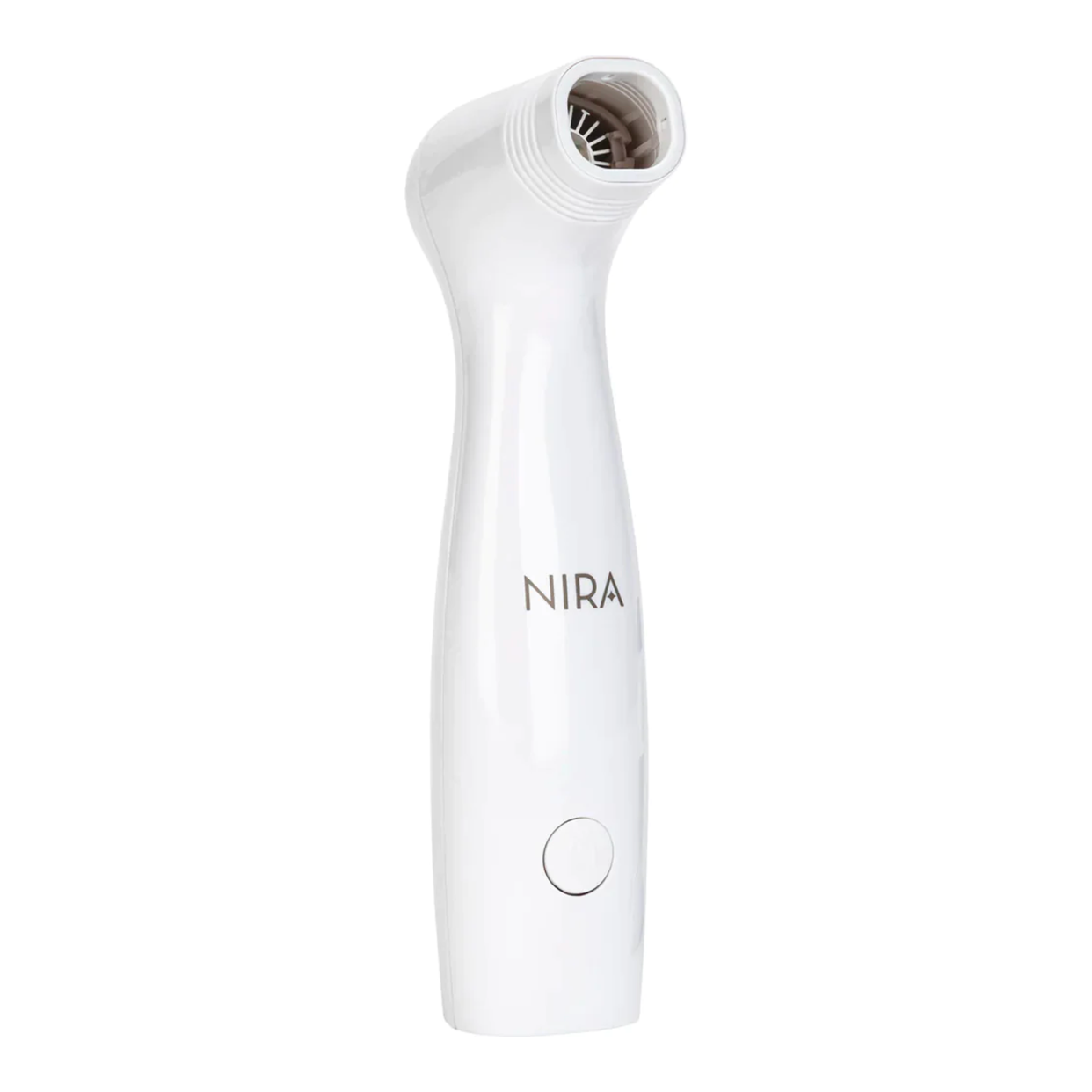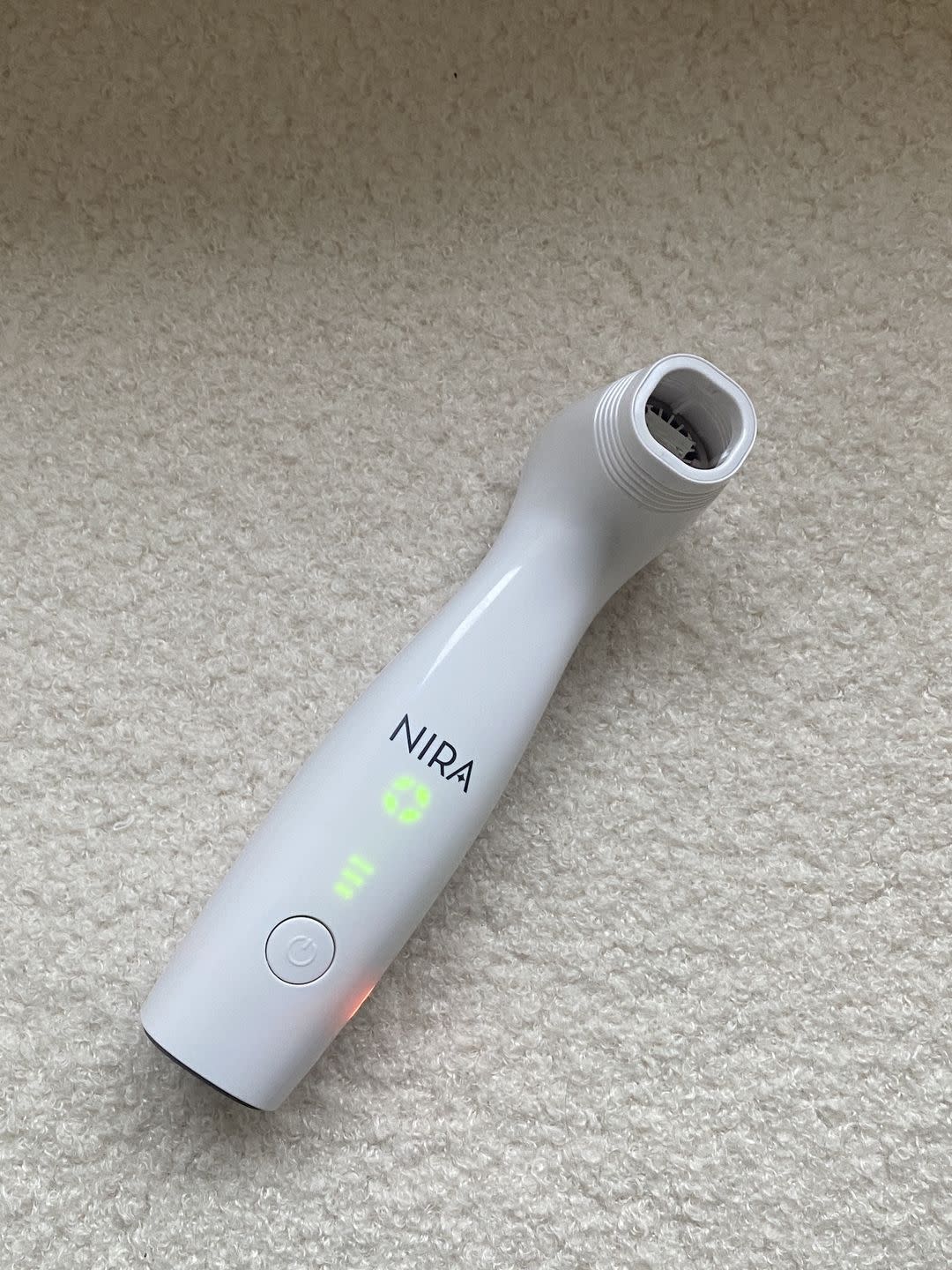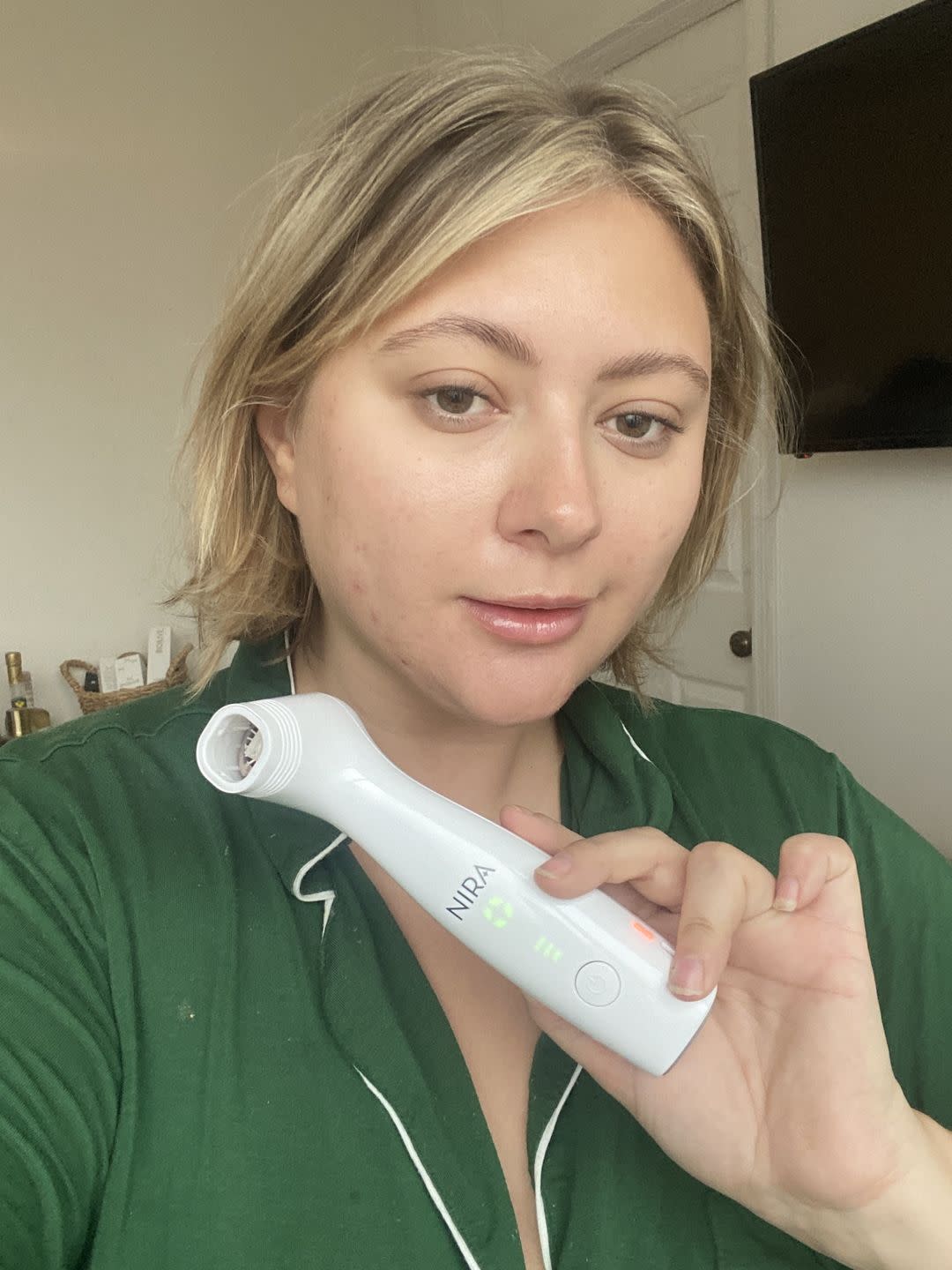This At-Home Laser Is Like a Magic Eraser to My Acne Scars
"Hearst Magazines and Yahoo may earn commission or revenue on some items through these links."
Considering just how many products are sitting at my desk rn, I'm actually a bit of a skeptic when it comes to skincare devices. I've texted derms and watched YouTube reviews for hours before I put microcurrent devices to the test. Similarly, I made sure deputy beauty director Lauren Balsamo could vouch for LED masks before I slapped one on my face. So when other beauty editors started sharing promising Nira Pro Laser reviews (especially for acne scars, which is my biggest skin concern rn), I was ready to see what it was all about,
With a handful of tips and the device in hand, I consulted a dermatologist about just how efficacious the Nira Pro Laser was and finally put it to work. And now, six months later, I'm here to report it's my favorite skincare device of all time. Yup! Allow me to break it down.
Pro Laser
Price: $599 (but often goes on sale, or you can use TK code for TK percent off)
Is it FDA-approved? It is FDA cleared
What it is: A non-ablative, non-fractional laser for at-home use
Who it's best for: Anyone who wants to smooth and prevent fine lines and wrinkles, as well as improve skin tone and quality, all in the comfort of your home
Our rating: 4.5/5

Pro Laser
niraskin.com
$750.00
Does the Nira Pro laser really work?
The Nira Pro laser really does work, according to New York board-certified dermatologist Hadley King, MD. "Nira stands out in the realm of home devices because it's a true laser," she says. "It's a diode laser with wavelength 1450 nm, and it has clinically proven results that last." (That's different from—and more powerful than—LED light or intense pulsed light, FYI.)
How does the Nira laser work:
It's pretty simple. "The Nira laser heats the dermis—aka the middle layers of your skin—which accomplishes three things: It kills old cells, resulting in skin renewal; it releases heat-shock proteins that help stimulate the building of new collagen; and it untangles old collagen, which helps remodel the collagen in your skin," Dr. King explains.
Basically, this is the same technology used in some in-office lasers, Dr. King adds. "The difference is that the fluence—aka the level of energy distributed—is lower, which makes it safe to use at home," she says. "By doing more passes at a lower fluence, you can achieve the same, or higher, cumulative energy used compared to in-office versions."
The Nira laser also uses a non-fractional laser, meaning it treats a larger surface area but a "plus doesn't cause much pain or irritation.

Benefits of the Nira Pro Laser:
First and foremost, the Nira Laser helps encourage collagen production, which can firm and tighten your skin to reduce fine lines and wrinkles from forming and smooth ones you've already got on your face. It also can possibly help fade hyperpigmentation by regenerating your skin, although these haven't been widely studied with the device like wrinkle reduction has just yet. (You'll see below, though—anecdotally, I noticed a major improvement here.)
TBH, there aren't really any major disadvantages to the Nira Pro laser, beyond the price and the heat you feel on your skin (which is mild, IMO). "Built-in safety mechanisms include real-time temperature detection and temperature calibration," Dr. King says; its ability to constantly monitor temperature explains why it feels so comfortable on my skin.
How to use the Nira Pro Laser:
Firstly, make sure your skin is clean and dry, says Dr. King. "This is important because the wavelength is 1450 nanometers, and this has peak absorption by water in the dermis," she adds. "If your skin is wet, then this water could absorb the energy, which could increase risk of discomfort."
Turn the device on, and choose your setting (there are five intensities; I always use the third). Then, all you'll do is stamp it across your skin. The device will beep twice: once when the laser has made contact with your skin, then another time when you can move onto the next area. Peep the TikTok below for a guide on how to use it:
As far as when to use your Nira Pro Laser, morning or nighttime doesn't matter, says Dr. King. "Whenever you have time after washing your face, use it for a few minutes before the rest of your skincare routine," she says. I always use mine in the morning because I load up on retinol at night to help reduce my acne.

My experience:
About my skin
My biggest skin concerns are acne scars and uneven skin texture, as well as active hormonal acne before my period. I don't have particularly sensitive or reactive skin (I can slather on 0.1 tretinoin every other day with zero peeling or irritation), but my face is extremely acne-prone and oily. Because of this, I'm extremely vigilant about checking every single product I use to make sure it doesn't contain pore-clogging ingredients, and I'm always on the hunt for treatments and devices to help get rid of my zits and hyperpigmentation.
How I used it:
I followed the above protocol by Nira, making sure to always glide the device across clean, dry skin once a day for a full month. I cover my entire face once, then go over any spots with acne scars one extra time with an extra zap. I notice legit zero redness or irritation afterward, so I can just go about my every day skincare routine as usual (i.e. patting on my mandelic acid serum, moisturizer, then sunscreen).
However, I am a busy gal, so I didn't always use my device once a day. But one v-nice aspect of the Nira Laser is that you don't have to use it every single day for the rest of your life to keep seeing results, according to Dr. King."Users can still see results two to six months later, even as use slows or stops," she says. So now that my scars have faded a bit and I'm feeling a little lazy (sry), I've dropped down to three times a week with my Nira.
My results:
I mean, you can see 'em for yourself right here:
I cannot believe how much less prominent my acne scars are since I started using the Nira Laser. Plus, I also feel like my acne doesn't scar as easily when I zap it with the laser. All of the zits I had in the before photo barely left any hyperpigmentation, which is basically magic considering nearly every single cystic zit has historically left deep, reddish-purple scars. For this feat alone, I'm pretty much obsessed with and now a lifetime fan of my Nira.
Other key observations? My pores look much smaller—which obviously, they aren't. (Pores cannot shrink or grow; I am stuck with this pore size for the rest of my life, thanks to my parents.) But they're so clear and my skin is so much firmer that they do appear tighter and less noticeable. I've actually had a handful of people say they can't see the pores on my face—a compliment I thought was reserved for the likes of Hailey Bieber.
I haven't noticed fine lines and wrinkles just yet (I am a youthful 27, after all), but I appreciate anything that'll keep my skin plump and smooth for as long as humanly possible—so I'm holding out for those benefits, too.
FWIW, Dr. King is also a big fan of the laser. She's used it on her own skin and thinks it's "very well-designed" and loves how easy and safe it is to use on her skin. "I really like that they have studies demonstrating clinical improvement and collagen production," she adds.
What is the difference between NIRA Pro and Precision laser?
Nira offers two types of lasers: the Pro laser and the precision laser. What's the diff? The Nira Precision Laser has a much smaller tip, which is genius for getting in those lil crevices, like under-eye wrinkles, or just zapping a few small acne scars on your cheeks. However, it totally can be used on your entire face (I actually used this before I got the Pro device); it just takes about double the time since the treatment window is so teeny. It's also $100 cheaper, which just might better fit your budget. Your choice depends on your budget, your goals, and your habits (for instance, are you more likely to use something that takes five minutes or 10 minutes?).
Which is better: Lyma or Nira?
Neither the Lyma laser nor the Nira laser is "better"; they're very different. The Lyma laser (which I've also tested extensively) is an at-home laser device that uses low-level laser therapy, which is non-ablative and non-invasive. It's considered a "cold laser" because it doesn't use heat to damage the layers of your skin to regenerate your skin; instead, it uses a complex lens system to diffuse its light up to 25,000 (!) times to remove the heat and evenly distribute the laser's energy throughout your skin. This is why it doesn't hurt or have any downtime whatsoever. The Nira Laser, however, does use heat, which is why it feels hot against your skin and can potentially be a little uncomfortable for some.
You've gotta be dedicated af to see long-term results from the Lyma laser, in my experience (we're talking 15 minutes a day, every day, for about three months). The Nira Laser, however, only takes about three to five minutes a day. And also, obviously, the price is the biggest difference. The Lyma Laser clocks in at $2,695, a whopping $2,000+ more than the Nira Laser. But you're def paying for a very high-tech product, so it really boils down to your own budget and how much time you wanna spend on your skin every day.
Final verdict:
While it's pretty expensive and takes some time to notice results, I'm a pretty big fan of my Nira Pro Laser. In my opinion, it's totally worth the price, considering how much more I'd spend for in-office lasers that provide similar results with way more pain and downtime. Obvi, before you try it yourself, contact your dermatologist to make sure it's the right tool for your skin and needs (I often make a list of devices and products I'm trying before appointments to run 'em by a pro who knows my skin). But if you're all about reducing fine lines and wrinkles or have some acne scars you'd like to disappear, you might become a fan of Nira too.
Meet the experts:
Hadley King, MD, is a board-certified dermatologist and clinical instructor of dermatology at the Cornell University's Weill Medical College.
Why trust Cosmopolitan?
Beth Gillette is the beauty editor at Cosmopolitan with five years of experience researching, writing, and editing skincare stories like reviewing EmSculpt Neo, pore vacuums, and at-home microdermabrasion devices. She tested out the Nira laser herself and chatted with dermatologists and estheticians all about it before writing this review.
You Might Also Like
